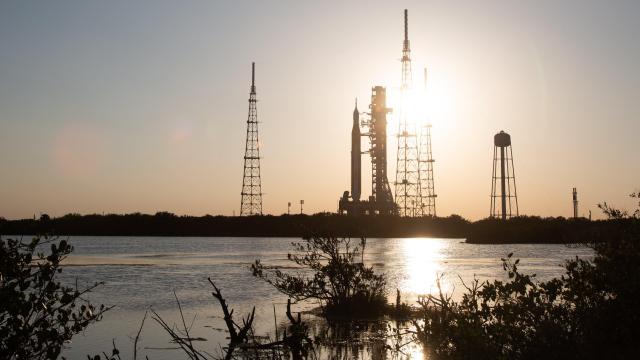NASA, after three failed attempts to complete a wet dress rehearsal of its Space Launch System, has decided to return its gigantic rocket to the Vehicle Assembly Building. The move will likely mean further delays to the Artemis 1 uncrewed mission to the Moon.
Space is hard — we get it — but the recently unconcluded SLS wet dress rehearsal was just plain sad.
Indeed, NASA couldn’t even complete a modified launch rehearsal this past Thursday, in which ground crews were attempting to load the rocket’s core stage with cryogenic propellants. A small hydrogen leak on the tail service mast umbilical was blamed for the test stoppage, with NASA saying it would re-run the modified launch test early this week. The space agency quickly changed its plans, however, announcing on Saturday that the 98.15 m-tall rocket will return to the Vehicle Assembly Building at Kennedy Space Centre for repairs.
The SLS wet dress launch rehearsal is being done in advance of the upcoming Artemis 1 mission, in which NASA will attempt to launch an uncrewed Orion capsule to the Moon and back, sans lunar landing. Standing on Launch Complex 39B at Kennedy Space Centre in Florida, the rocket was to be fully loaded with propellant and a countdown stopped just prior to the ignition of its four RS-25 engines, but neither of those things happened. It’s not a fantastic result, as SLS represents a critical component of the Artemis program, which seeks to land U.S. astronauts on the Moon later this decade.
In its press release, NASA said the decision to roll SLS and the Orion capsule back to the VAB was “due upgrades required at an off-site supplier of gaseous nitrogen used for the test.” The nature of these upgrades and the time required to implement them weren’t disclosed, but the space agency said it would “take advantage of the opportunity” to fix the rocket directly in the hangar.
Specifically, NASA needs to swap out a faulty helium check valve that prevented ground crews from loading supercooled liquid oxygen and liquid hydrogen into the rocket’s second stage during the second wet dress attempt. The valve, measuring just 3 inches long, can only be accessed when the rocket is inside the VAB. NASA will also use this time to fix the leaky umbilical, review the results of the test, go over its schedule, and decide on the remaining list of SLS test requirements.
That NASA will have to perform another wet dress rehearsal now seems likely. Officials with the space agency have stressed that nothing is fundamentally wrong with the rocket and that they’re simply having to deal with minor, or “nuisance,” issues. That may very well be the case, but the sheer volume of issues and the incessantly stilted manner in which the propellant loading was being performed, does seem problematic.
The SLS wet dress started on April 1, but a steady slew of problems prevented the test from running to its completion. These problems included faulty ventilation fans on the mobile launcher, a misconfigured manual vent valve, overly cold temperatures and frost during propellant loading, and the aforementioned problem with the third-party supplier of gaseous nitrogen. A lightning storm on April 2 and the Axiom Space mission to the International Space Station, which launched from Kennedy Space Centre on April 8, also contributed to delays.
Charlie Blackwell-Thompson, Artemis launch director, said it will take ground crews approximately 10 days to prepare SLS for its crawling, 4-mile (6.4-kilometre) journey back to the VAB, which will take approximately 12 hours. A second stint to perform a full wet dress rehearsal, should it happen, isn’t imminent. As for the Artemis 1 mission, the next three windows for launch are June 1 to 16, June 29 to July 17, and July 26 to August 9.
NASA has scheduled a media teleconference for 3:00 p.m. EDT today to discuss the state of SLS and the wet dress in more detail. We’ll be updating this article with new information as it becomes available.
